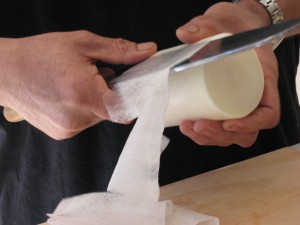繊切り Sengiri is the Japanese word meaning to Julienne. The kanji character 繊 (sen) means fine or fibre; 切り(kiri) means to cut. So sengiri refers to julienned fibres that is about 1-2mm thick.
A finer version of sengiri is 針切りHarigiri or needle thin julienne, 針 (hari) is needle.
In the case of Wagyu Shigureni, a sweet simmered wagyu dish we featured in our Shokado Bento class, harigiri (needle thin) ginger is required. We’ve tried to teach this in class, but even with our very sharp knives, most people end up with matchsticks at best, not needles or fibres.
I’ve posted a short video of the sengiri/harigiri ginger technique on our facebook page.
This is a good technique to know and crucial in Japanese cooking. The idea is to cut ALONG THE GRAIN, not against. Along the grain preserves the needle/fibre shape and texture of the vegetable. If you cut against the grain, the vegetable will fall apart once cooked or transformed in some way.
We use this sengiri technique with carrots a lot too, and also daikon, cucumber and other vegetables that end up in aemono or sunomono dishes.
Of course, sengiri is how the finely shredded daikon garnish for sashimi is made. To achieve this, you have to be able to do katsuramuki (see pic) first to produce the paper thin strip of daikon, which is then sliced using sengiri/harigiri. This is excessively difficult! We covered this in our knife skills class some years ago with Kazu san. (There’s no shame in employing a shredder or mandolin in this case!)
by Masako Fukui, Copyright Kei’s Kitchen

